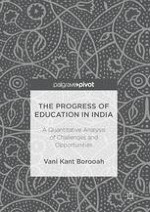
2017 | OriginalPaper | Buchkapitel
1. Issues in International Higher Education
verfasst von : Vani Kant Borooah
Erschienen in: The Progress of Education in India
Aktivieren Sie unsere intelligente Suche, um passende Fachinhalte oder Patente zu finden.
Wählen Sie Textabschnitte aus um mit Künstlicher Intelligenz passenden Patente zu finden. powered by
Markieren Sie Textabschnitte, um KI-gestützt weitere passende Inhalte zu finden. powered by